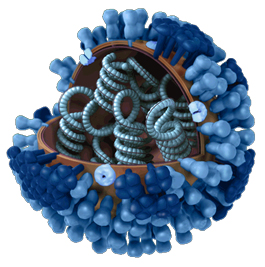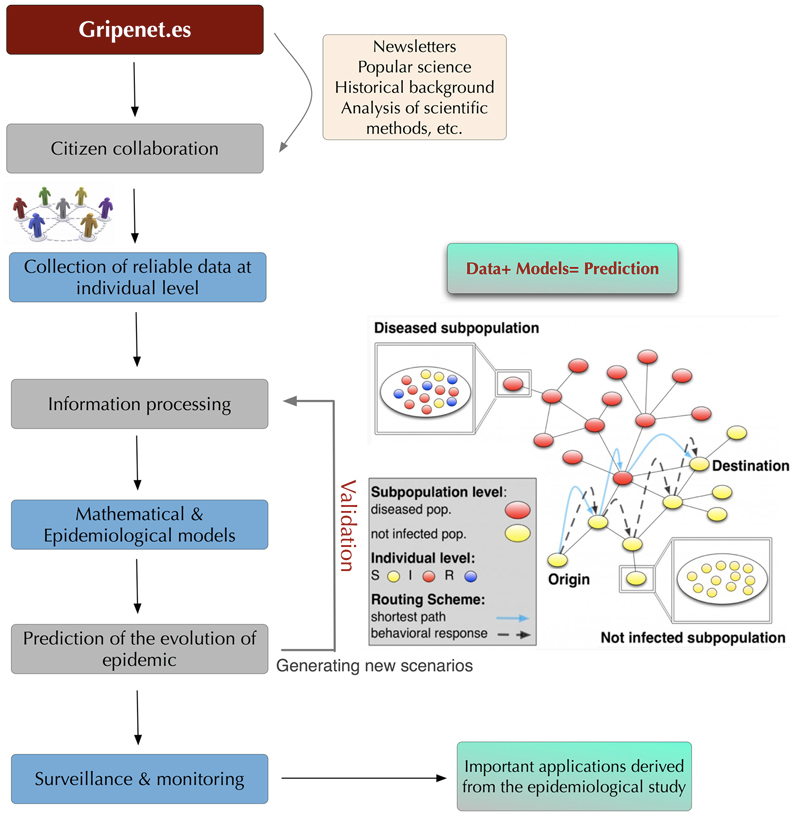Epidemiology
Classical Epidemiology Multi-scale Diseases Tuberculosis (TB) Spreading Gripenet.es (Sp. Version)Gripenet.es (Sp. Version)
As we already know, the flu is one of the most contagious viral diseases in the world. Each year, it is responsible for the deaths of hundreds of thousands of people worldwide and throughout history; it has caused more deaths than any other known disease. This represents a serious problem for public health at a global scale with a significant human and economic impact.
Influenza outbreaks affect the economies of developed countries causing work absenteeism, declines in productivity and business losses. However, these outbreaks are in most cases effectively controlled by health authorities through vaccination campaigns, use of antiviral drugs, a proper health education of the population based on the adoption of certain hygiene countermeasures to break the germ transmission chain or to prevent the spread of illness, an adequate medical care by health professionals, etc.
Nevertheless, in developing countries, where much of the population lives below the poverty line, a lot of factors contribute to make influenza episodes an even bigger problem. The shortage of essential medicines, water and sanitation deficits, hunger, malnutrition, poor health care systems, the proximity of people to domestic poultry and mammals that are susceptible to be infected by influenza viruses (in Southeast Asian countries), the insufficient epidemiological control by local health authorities, among others, make influenza-like-illness to have dramatic effects for the population. So, what would happen if a pandemic were declared? With the actual globalization and the new patterns of population mobility, the consequences would be unfortunate for all.
As it happens in earthquakes, it is impossible to predict when a pandemic will occur, but we should be able to develop more accurate epidemiological models based on real data obtained directly from the affected population. This will allow the establishment of efficient protocols for preventing the fast spread of the illness.
 In nature, all mutations occur at random and viruses have a relatively high mutation rate. This means that changes that take place at the genetic level in influenza viruses are continuously monitored and analyzed by local and international health authorities. Nowadays, the highly pathogenic avian influenza strain H5N1 that caused the outbreak of bird flu epidemic in humans in South-east Asia in 2003, is the most lethal and aggressive of known strains. The measures to contain the spread of the disease are mainly focused on aspects such as: food safety control, to avoid the contact with contaminated poultry products, to apply risk reduction strategies throughout the food chain, to enforce regulations for food export, etc. Studies of viral samples have shown that virus subtype H5N1 is becoming more pathogenic for mammals, is more resistant than before and can survive in the external environment many more days. Today, the main concern is that a co-infection by human influenza and avian influenza viruses might occur in a person. This would lead to a reassortment of genetic material of both strains and to the emergence of a new subtype of pandemic virus. Reassortment is an event in which genetic material is exchanged between human and avian viruses during co-infection of a human or pig.
In ancient times, an epidemic like the Black Death took years to propagate throughout the world, but today modern, fast, and long-range transportation means like air traffic, human migration, the increase of population in metropolitan areas and the existence of a dynamic and interconnected world, makes it possible that an epidemic spreads all over the planet in a few days or even hours.
As scientists, we urge citizens of all countries and institutions to work together to promote the research in this field of study. This joint effort will allow researchers to improve current epidemiological models, protocols and health policies. We really hope that the above reasons contribute to the achievement of our goals and objectives.
In nature, all mutations occur at random and viruses have a relatively high mutation rate. This means that changes that take place at the genetic level in influenza viruses are continuously monitored and analyzed by local and international health authorities. Nowadays, the highly pathogenic avian influenza strain H5N1 that caused the outbreak of bird flu epidemic in humans in South-east Asia in 2003, is the most lethal and aggressive of known strains. The measures to contain the spread of the disease are mainly focused on aspects such as: food safety control, to avoid the contact with contaminated poultry products, to apply risk reduction strategies throughout the food chain, to enforce regulations for food export, etc. Studies of viral samples have shown that virus subtype H5N1 is becoming more pathogenic for mammals, is more resistant than before and can survive in the external environment many more days. Today, the main concern is that a co-infection by human influenza and avian influenza viruses might occur in a person. This would lead to a reassortment of genetic material of both strains and to the emergence of a new subtype of pandemic virus. Reassortment is an event in which genetic material is exchanged between human and avian viruses during co-infection of a human or pig.
In ancient times, an epidemic like the Black Death took years to propagate throughout the world, but today modern, fast, and long-range transportation means like air traffic, human migration, the increase of population in metropolitan areas and the existence of a dynamic and interconnected world, makes it possible that an epidemic spreads all over the planet in a few days or even hours.
As scientists, we urge citizens of all countries and institutions to work together to promote the research in this field of study. This joint effort will allow researchers to improve current epidemiological models, protocols and health policies. We really hope that the above reasons contribute to the achievement of our goals and objectives.

COSNET Lab, BIFI, University of Zaragoza.
Spanish platform: Gripenet.es, with the collaboration of Ibercivis Foundation (for citizen science).
Spanish platform: Gripenet.es, with the collaboration of Ibercivis Foundation (for citizen science).


